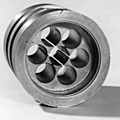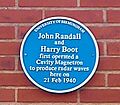Harry Boot facts for kids
Quick facts for kids
Harry Boot
|
|
|---|---|
| Born | 29 July 1917 |
| Died | 8 February 1983 (aged 65) |
| Nationality | English |
| Alma mater | University of Birmingham |
| Known for | cavity magnetron |
| Scientific career | |
| Fields | physics |
| Doctoral advisor | Mark Oliphant |
Henry Albert Howard Boot (born July 29, 1917 – died February 8, 1983) was a smart English scientist. He was a physicist, which means he studied how the world works. Along with Sir John Randall and James Sayers, he helped create a super important invention called the cavity magnetron. This device was a big secret weapon that helped the Allies win World War II.
Contents
Early Life and Education
Henry Boot was born in a city called Birmingham, England. He went to a school there called King Edward's School, Birmingham. After that, he studied at the University of Birmingham. He was working on his advanced degree, called a PhD, when World War II started.
Inventing the Cavity Magnetron
Henry Boot's professor, Mark Oliphant, had seen an early version of a radar device called a klystron. But it wasn't powerful enough to be useful for radar. Radar uses radio waves to find objects. Professor Oliphant gave Henry Boot and John Randall a big challenge: make a much stronger device.
They worked very hard on this problem. By early 1940, they had invented something amazing: the cavity magnetron. This new device could create very powerful radio waves. It was much better than anything else at the time. By May 1940, it was already being tested in a real radar system.
How the Magnetron Helped in World War II
The cavity magnetron was a game-changer for radar. It made radar systems much more accurate and powerful. This was super important during World War II. It helped planes and ships find enemy targets, even in the dark or bad weather. It also helped defend against enemy attacks.
Later, another scientist named James Sayers made the magnetron even better. He added special "straps" to it. This made it work even more efficiently.
Recognition for Their Work
At first, Henry Boot and John Randall only got a small reward for their invention. They each received £50 for "improving the safety of life at sea." But in 1949, they, along with James Sayers, received a much bigger prize of £36,000 for their amazing work. This showed how important their invention truly was.
After the War
After the war, Henry Boot went back to the University of Birmingham. He became a special research fellow. He worked on different areas of physics, including nuclear physics. He even helped build a cyclotron at the university. A cyclotron is a machine that speeds up tiny particles.
In 1948, he started working for the government as a scientist. He worked at the Services Electronic Research Laboratories in Baldock, England. There, he continued to study microwaves, magnetrons, and even lasers.
Personal Life and Retirement
Henry Boot loved to sail. He owned two boats in a place called Salcombe in Devon. He often went there with his wife, Penelope, and their two sons, Christopher and Nicholas. They had a family holiday home there.
He retired from his scientific work in 1977. Henry Boot passed away in Cambridge on February 8, 1983, when he was 65 years old. His invention, the cavity magnetron, changed the world and helped protect many lives.
Images for kids




